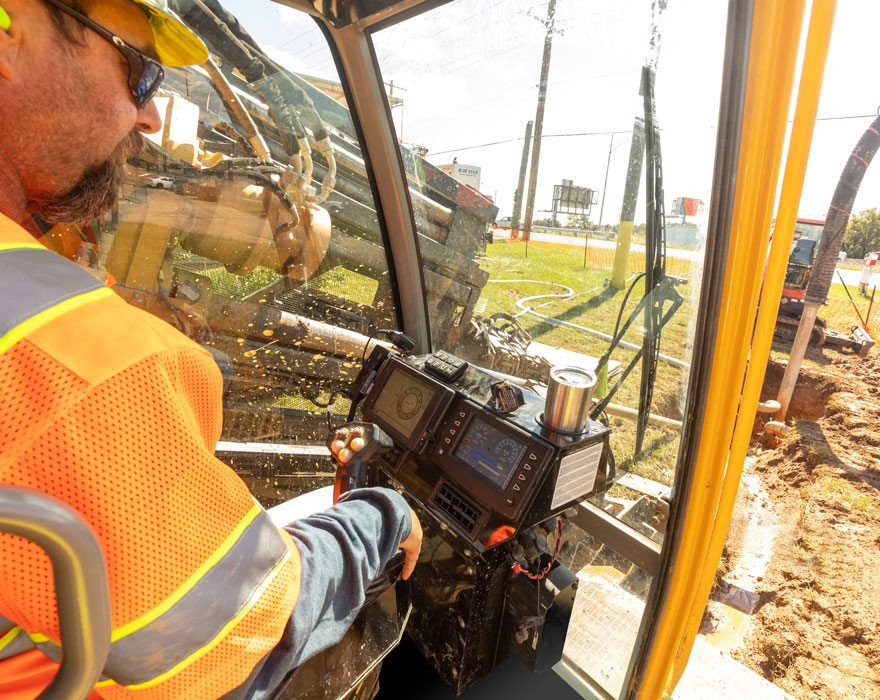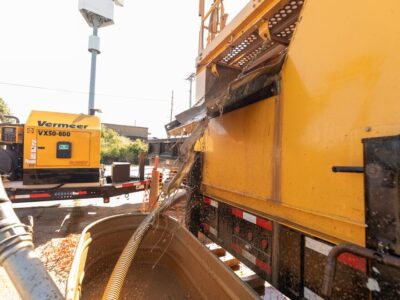Funding for urban infrastructure development, facilitated by initiatives like the Infrastructure Investment and Jobs Act, is fueling expansion in projects modernizing water, electrical and gas distribution. To make these essential upgrades in urban areas without disrupting the public and existing infrastructure, many utilities and municipalities are turning to trenchless technology.
Installing large-diameter products with horizontal directional drills (HDDs) helps minimize the impact on people living in the community, but it does come with its own set of challenges. Effective planning is essential due to the space requirements for larger drills and support equipment. Additionally, working near the public necessitates considerations such as traffic control and noise restrictions.
“When you think about big rigs working in residential areas, it’s really about the logistics,” said Marv Klein, solution specialist at Vermeer. “How can you plan that project out in advance to be the most efficient and minimize disruption to the general public?”
How you route traffic, manage fluid and position machines on the right-of-way are key variables when making your plan. Footprint limitations, handling products to be installed and noise limits deserve careful consideration.
Consider footprint limitations
Equipment selection for urban infrastructure development gains prominence when working on a tight right-of-way. Having enough space for all the equipment required to execute a large-diameter bore is one of the more important factors to consider while planning the project.
It’s essential to assess the footprint requirements at both the entry and exit points of the jobsite in comparison to the available equipment. Urban environments often impose restrictions on setup space, emphasizing the need for specific machine configurations tailored to tight-access applications. For example, the Vermeer D220x500 S3 HDD is offered with either a 30-ft (9.1-m) drill rack or a 20-ft (6.1-m) drill rack. Opting for a 20-ft drill rack provides an overall smaller footprint for tighter right-of-way scenarios.
“Using a shorter drill rig may affect your production rate because you have 20-ft drill rods instead of 30-ft drill rods. But with the space available, you may have no other choice.”
The limitations imposed by footprint constraints in urban infrastructure development projects can present significant challenges in fluid management. When drilling large-diameter holes using HDD, there is often a need to handle and maintain large quantities of fluid. Vermeer reclaimers are typically instrumental in mud management; however, in tightly confined urban areas, there might not be sufficient space to position a reclaimer on the exit side of the bore. In such scenarios, you need to devise a plan to efficiently move fluid from the exit pit to the entry side.
There may not be enough space to maneuver around the site with big vacuum trucks or to dig a large receiving pit to be contained before it goes back to the reclaimer. Consequently, you may need to continuously run smaller vac trucks and trailer vacs back and forth from the exit side of the borehole to the drill side.
Plan for product installation
Carefully consider any limitations on the exit side of the bore when developing the initial plan for an urban infrastructure development project. Many of these larger-diameter bores can span 1,000 ft to beyond 2,000 ft (305 m to beyond 610 m). Once the pilot bore is completed and the borehole has been reamed to the desired size, it is time to install the product. This requires access to the exit side of the borehole.
“That can be a big part of the planning when it comes to working in residential areas,” said Klein. “We’ve seen scenarios where roads had to be blocked off and traffic rerouted, which has a big impact on the general public. We’ve seen where cranes were brought in to elevate pipe above the roads and projects where there wasn’t ample space to string out the product pipe. In these scenarios, the product was pulled in multiple sections, which requires mid-welds and adds time to the overall project. It takes extra planning and foresight when you are working on these types of projects.”

Be aware of noise limits
Noise is a very common concern in urban infrastructure development projects. Make sure you are aware of any city noise restrictions and plan accordingly to prevent unexpected noise abatement costs.
“Projects may have a decibel sound level they have to meet,” said Klein. “It’s important customers understand the sound levels of their equipment. They’re bidding on a project and they have a certain sound level that they have to meet at a certain distance away from the machine.”
In instances where noise restrictions are in place, compliance may necessitate the construction of sound barrier walls. Often, this responsibility falls on the HDD contractor. For jobs facing difficult sound restrictions, some companies specialize in sound barrier walls specifically for inner-city work.
Choose a partner for success
The surge in funding aimed at upgrading aging urban infrastructure has created a strong demand for large-diameter HDD services. Careful logistical planning for operations in these environments can position your company as a reliable partner for municipalities and utility companies. Your local Vermeer dealer is ready to back you up during each step of the project, from planning to on-the-job support.
Vermeer Corporation reserves the right to make changes in engineering, design and specifications; add improvements; or discontinue manufacturing at any time without notice or obligation. Equipment shown is for illustrative purposes only and may display optional accessories or components specific to their global region.
Please contact your local Vermeer dealer for more information on machine specifications. Vermeer and the Vermeer logo are trademarks of Vermeer Manufacturing Company in the U.S. and/or other countries.
© 2024 Vermeer Corporation. All Rights Reserved
